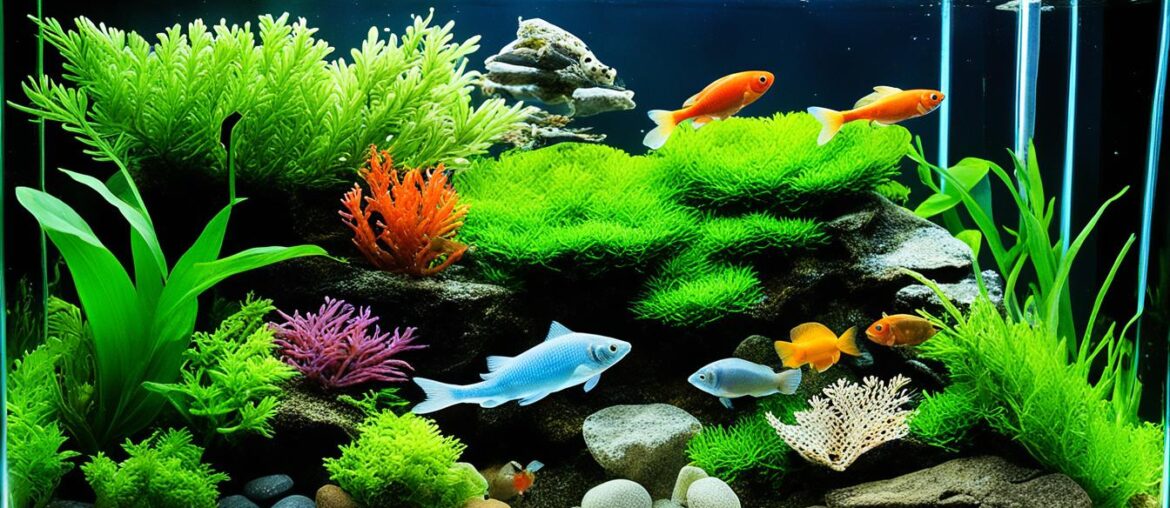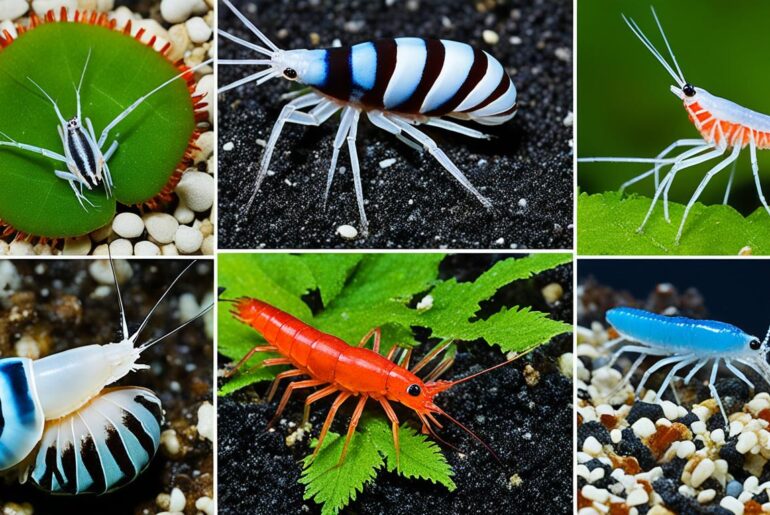Are you a beginner aquarium owner looking for low-maintenance aquatic pets that are simple to care for? Look no further! In this article, I will introduce you to the top 5 easy-to-care-for freshwater invertebrates that will make your aquarium experience stress-free and hassle-free. Get ready to explore the world of effortless freshwater invertebrates that will add beauty and interest to your tank.
Key Takeaways:
- Easy to Care for Freshwater Invertebrates can make your aquarium-keeping experience enjoyable and stress-free.
- Low-maintenance aquatic pets are perfect for beginners.
- Beginner-friendly water creatures require minimal upkeep.
- Simple care aquarium invertebrates add beauty and interest to your tank.
- Stress-free freshwater invertebrates create a hassle-free aquarium experience.
Shrimp – A Great Choice for Easy Care Invertebrates
Shrimp are one of the most popular choices for easy care freshwater invertebrates. They come in various species, such as Amano shrimp, Cherry shrimp, and Crystal Red shrimp. These shrimp are not only beautiful but also low-maintenance, making them ideal for beginners.
One of the advantages of keeping shrimp in your aquarium is their low bioload. This means that you can have a larger group of shrimp without overwhelming your tank’s filtration system. Watching these small creatures scuttle around the tank can be quite entertaining and provide a calming presence.
An additional benefit of having shrimp in your aquarium is their cleaning abilities. These tiny critters are known for their voracious appetite and are excellent at scavenging leftover food and eating unwanted algae, helping to keep your tank clean and balanced. This natural form of algae control reduces the need for manual cleaning and promotes a healthier environment for your aquatic pets.
Shrimp are suitable for tanks of various sizes, making them a versatile choice for beginners. Whether you have a small desktop tank or a larger setup, you can find a shrimp species that will thrive in your specific environment.
Adding shrimp to your freshwater aquarium not only enhances its beauty but also promotes a stress-free and low-maintenance aquatic ecosystem. So why not consider these fascinating invertebrates as your next aquatic pets?
Crayfish – A Unique and Easy Care Invertebrate Option
When it comes to easy care aquarium invertebrates, crayfish are a standout choice. These fascinating water creatures add a touch of uniqueness to your tank and require minimal maintenance. Whether you’re a beginner or an experienced aquarist, crayfish can be a great addition to your aquatic pets.
Dwarf crayfish, in particular, are recommended for their easy care nature. They have intriguing personalities and provide endless entertainment as you observe their behavior. Unlike their larger counterparts, dwarf crayfish are less aggressive and can be kept with non-carnivorous tankmates, making them beginner-friendly.
To ensure the well-being of your dwarf crayfish, it is important to provide them with suitable hiding places. These aquatic pets appreciate the security of caves or dense vegetation in the tank. A tank size of at least 8 gallons allows them enough space to explore and thrive.
If you’re looking for a more eye-catching option, electric blue crayfish are available. However, it’s important to note that they are larger and more aggressive than dwarf crayfish. As a result, they require a larger tank and careful consideration of tankmates to avoid any conflicts.
Overall, crayfish are low-maintenance aquatic pets that bring a unique charm to your aquarium. Their easy care requirements, combined with their interesting behavior, make them a great choice for beginners and experienced aquarists alike.
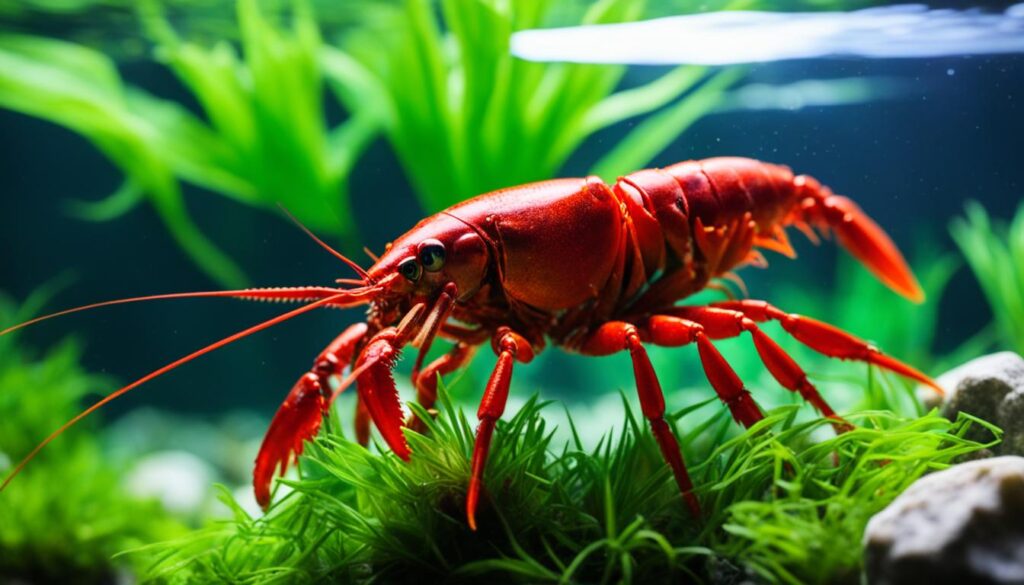
Crabs – Small Invertebrates with Big Personalities
Crabs can be a fascinating addition to your aquarium, bringing a unique charm with their small size and big personalities. These easy care aquarium invertebrates are ideal for beginners looking for low-maintenance aquatic pets. While some crab species require more complex setups with access to land or brackish water, there are freshwater crabs like the Thai micro crab that are entirely aquatic and much easier to care for.
One popular choice is the Red Claw Crab, known for its vibrant color and active nature. However, it’s important to note that Red Claw Crabs require a paludarium setup with access to both land and brackish water to thrive properly.
For a simpler option, the Thai micro crab is a great choice. These small crab species are fully freshwater and can adapt well to a standard aquarium setup. They are omnivorous, feeding on both leftover food and algae, making them effective cleaners for your aquarium.
As with any aquatic pet, it’s important to ensure that the tank is properly maintained and the water parameters are suitable for the crabs. Regular water changes and monitoring of temperature and pH levels are necessary to keep these fascinating creatures healthy and thriving.
Add some small hiding spots and decorations to mimic their natural habitat, and you’ll have a captivating display in your aquarium. Just make sure to choose tankmates carefully, as some fish may view the crabs as a potential snack.
Snails – Nature’s Clean-Up Crew in the Aquarium
When it comes to maintaining a clean and balanced aquarium, snails are often underestimated. These easy care aquarium invertebrates play a vital role in keeping the environment pristine and healthy. Snails, such as ramshorn snails, nerite snails, and Malaysian trumpet snails, are excellent cleaners that help to eliminate algae, decaying plant matter, and even dead fish from the tank.
Not only do snails contribute to the overall cleanliness of the aquarium, but they also provide additional benefits. They help to aerate the substrate, preventing the buildup of harmful gases, and assist in breaking down organic waste. Furthermore, snails can be helpful to live aquarium plants by consuming decaying plant material and keeping their leaves clean.
One of the remarkable aspects of snails is their variety. They come in various colors and patterns, adding visual interest and charm to any aquarium. Whether you prefer the vibrant hues of the ramshorn snails or the striking patterns of the nerite snails, there is a wide range of options to suit your aesthetic preferences.
If you’re looking for stress-free freshwater invertebrates that require minimal maintenance and contribute to a clean and thriving aquarium, snails are an ideal choice. Their ability to keep algae and debris under control, as well as their beneficial impact on the ecosystem, make them valuable additions to any tank.
“Snails bring unique beauty to the aquarium while playing a crucial role in maintaining a healthy environment. Their voracious appetite for algae and their efficient cleaning abilities make them an asset to every aquarist.” – Me, Aquarium Enthusiast
To highlight the benefits of snails in the aquarium, here is a comparison table:
| Snail Species | Cleaning Abilities | Contribution to Plant Health | Visual Appeal |
|---|---|---|---|
| Ramshorn Snails | Efficient algae eaters and organic waste cleaners | Helps clean decaying plant matter and keeps leaves tidy | Varied colors and patterns add visual interest to the tank |
| Nerite Snails | Relentlessly consume algae, even tough varieties | Aids in algae control, preventing algal blooms | Distinctive patterns and shell shapes create an eye-catching display |
| Malaysian Trumpet Snails | Diligently burrow in the substrate, preventing anaerobic areas | Helps to aerate the substrate and break down organic waste | Elongated spiral-shaped shells bring a unique look to the tank |
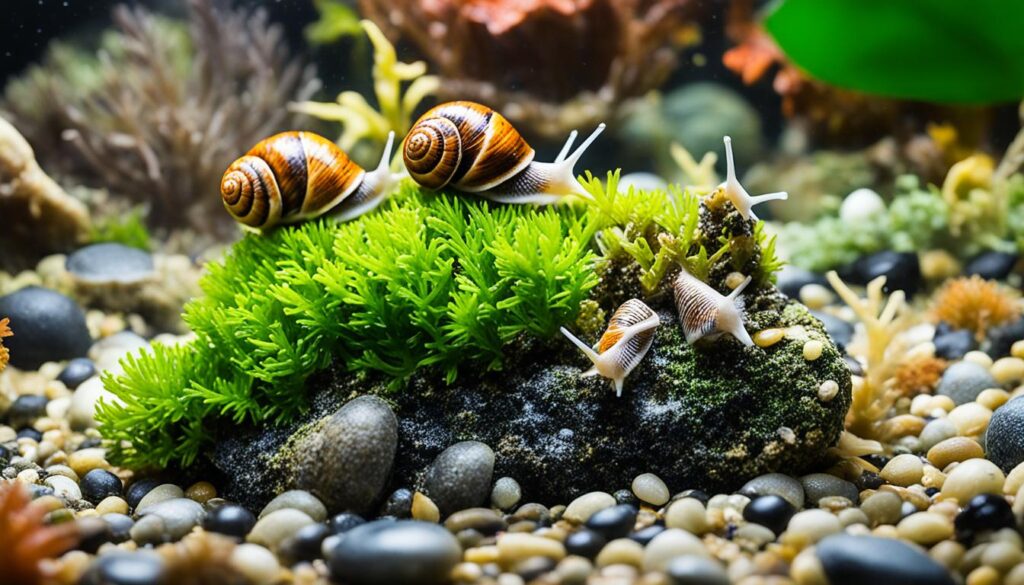
In conclusion, snails are nature’s clean-up crew in the aquarium. These easy care aquarium invertebrates offer hassle-free maintenance, effectively control algae and debris, and contribute to the health of both the tank and its inhabitants. With their attractive appearances and functional benefits, snails are an excellent addition to any freshwater aquarium.
Rainbow Sharks and Redtail Sharks – Surprising Clean-Up Crew Members
Rainbow Sharks and Redtail Sharks are not your typical clean-up crew members, but they have unique skills that make them valuable additions to any aquarium. These sharks may be known for their stunning colors and graceful swimming, but they also play an important role in maintaining a clean environment.
These scavengers have an appetite for excess food and algae, helping to keep the aquarium free from debris and maintaining water quality. By adding Rainbow Sharks or Redtail Sharks to your tank, you are not only introducing a beautiful and fascinating aquatic pet, but also a natural cleaning crew.
Although Rainbow Sharks and Redtail Sharks have similar cleaning tendencies, they are distinct species with their own characteristics. Rainbow Sharks (Epalzeorhynchos frenatum) are known for their vibrant colors, while Redtail Sharks (Epalzeorhynchos bicolor) have a distinctive red tail that gives them their name.
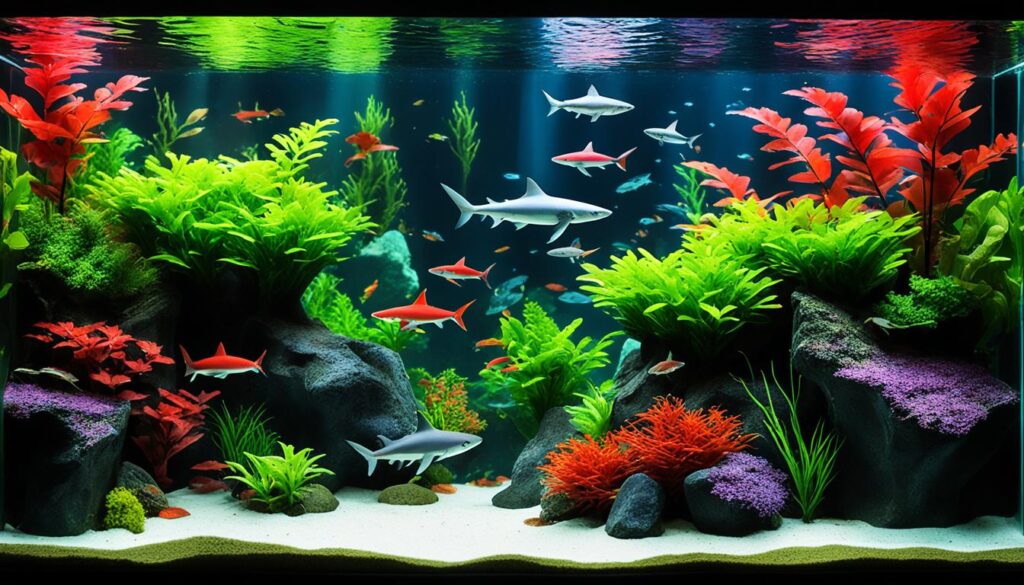
It is important to note that these sharks can be territorial, especially when it comes to their own kind. Therefore, it is recommended to keep only one Rainbow Shark or Redtail Shark in a tank of sufficient size to prevent aggression. The tank should provide enough space for the shark to establish its territory without intruding on other tankmates.
The Key Features of Rainbow Sharks and Redtail Sharks:
- Excellent scavengers that clean up excess food and eat algae
- Help to maintain a clean environment and promote water quality
- Distinctive colors and patterns, adding visual interest to the aquarium
- Can be territorial, so it is essential to provide adequate space for each shark
Adding Rainbow Sharks or Redtail Sharks to your aquarium not only enhances its aesthetic appeal but also ensures a healthier and cleaner aquatic environment. These low-maintenance aquatic pets are a surprising and valuable addition to any freshwater tank.
| Rainbow Sharks | Redtail Sharks |
|---|---|
| Epalzeorhynchos frenatum | Epalzeorhynchos bicolor |
| Vibrant colors | Distinctive red tail |
| Territorial | Territorial |
| Suitable for 55-gallon tanks or larger | Suitable for 55-gallon tanks or larger |
Eartheaters – Nature’s Substrate Cleaners
Eartheaters, a group of South American cichlids, are fascinating freshwater invertebrates that serve as nature’s substrate cleaners in the aquarium. These unique aquatic pets have a remarkable ability to scoop up substrate and filter it through their gills, consuming edible leftovers and breaking down waste. This natural behavior helps maintain a cleaner and healthier environment for your aquarium inhabitants.
Unlike many cichlids, Eartheaters are peaceful bottom dwellers, making them suitable for community tanks of 55 gallons or larger. They are known for their beautiful colors and unique patterns, adding visual interest to your aquarium. Many aquarists are drawn to the intriguing behavior of Eartheaters as they dig through the substrate, creating interesting landscapes in the tank.

One popular eartheater species is the Geophagus, which includes several varieties such as Geophagus brasiliensis and Geophagus steindachneri. These cichlids are generally peaceful and can coexist with other non-aggressive tankmates. However, it’s essential to provide ample hiding places and territories to prevent aggression.
Benefits of Keeping Eartheaters in Your Aquarium
Keeping Eartheaters in your aquarium offers several advantages beyond their role as substrate cleaners. Here are some key benefits:
- Low Maintenance: Eartheaters are easy care aquarium invertebrates, requiring minimal attention and maintenance. They are resilient and adaptable to different water conditions, making them suitable for beginner aquarists.
- Unique Behavior: Watching Eartheaters sift through the substrate is a captivating sight. Their digging behavior not only adds a natural element to your tank but also provides essential aeration for plant roots.
- Community Compatibility: Eartheaters are generally peaceful and can coexist with a variety of tankmates, including other non-aggressive fish and invertebrates. However, it’s important to research specific species compatibility before adding them to your aquarium.
“Eartheaters not only clean the substrate, but they also add a touch of natural beauty and intrigue to the aquarium. Their behavior and unique patterns make them a standout choice for aquarists looking for something different.”
– Aquarist Magazine
If you’re looking for an easy care aquarium invertebrate that brings both functionality and beauty to your tank, Eartheaters are an excellent choice. With their substrate cleaning abilities and peaceful nature, they offer a low-maintenance and interesting addition to any aquarium.
| Common Name | Scientific Name | Size | Minimum Tank Size |
|---|---|---|---|
| Geophagus brasiliensis | Geophagus brasiliensis | Up to 8 inches | 55 gallons |
| Geophagus steindachneri | Geophagus steindachneri | Up to 7 inches | 55 gallons |
| Ramirezi Cichlid | Mikrogeophagus ramirezi | Up to 3 inches | 20 gallons |
Flagfish – Algae Eating Wonders
Flagfish, particularly the males with their beautiful striped patterns, are great options for controlling algae in the aquarium. They have mouths that are uniquely shaped for pulling off hair algae and black beard algae.
While they may damage delicate plants in the process, they provide valuable algae control. Flagfish are active and should be kept in tanks of at least 20 gallons with fast tank mates.

The unique shape of a Flagfish’s mouth allows them to effectively remove hair algae and black beard algae from your aquarium, keeping it clean and free from excessive algae growth.
If you’re tired of battling algae in your tank, adding Flagfish to your aquarium can help maintain a clean and visually appealing environment. These vibrant and active fish make a beautiful addition while also serving as excellent algae eaters. Just make sure to provide them with enough space to swim and house them with fast-moving tank mates.
Conclusion
In conclusion, if you’re looking for easy-to-care-for freshwater invertebrates, there are plenty of options that are perfect for beginners. Shrimp, crayfish, crabs, snails, rainbow sharks, redtail sharks, eartheaters, flagfish, and even goldfish and plecos can all serve as low-maintenance clean-up crew members in your aquarium. These invertebrates not only add beauty and interest to your tank, but they also help maintain a clean environment by eating excess food and algae.
Whether you have a small tank or a larger setup, there is a suitable option for everyone. Each of these beginner-friendly water creatures requires minimal upkeep, making them perfect for those who are new to aquarium keeping. Choose the invertebrate that best fits your tank size and compatibility needs, and get ready to enjoy a hassle-free and enjoyable aquarium experience.
With easy-to-care-for freshwater invertebrates, you can create a stress-free and simplistic aquatic environment. These low-maintenance aquatic pets provide an effortless way to introduce life and vibrancy into your tank, without the need for constant attention or complicated care routines. So, dive into the world of beginner-friendly water creatures and discover the joy of nurturing these fascinating invertebrates in your own home.
FAQ
What are the top 5 easy care freshwater invertebrates for beginners?
The top 5 easy care freshwater invertebrates for beginners are shrimp, crayfish, crabs, snails, and rainbow sharks or redtail sharks.
Why are shrimp a great choice for easy care invertebrates?
Shrimp are a great choice for easy care invertebrates because they come in various species, have low bioloads, clean up leftover food and unwanted algae, and can be kept in tanks of various sizes.
Why are crayfish a unique and easy care invertebrate option?
Crayfish are a unique and easy care invertebrate option because they have intriguing personalities, are interesting to watch, and dwarf crayfish are less aggressive than their larger counterparts, making them suitable for keeping with non-carnivorous tankmates.
What makes crabs small invertebrates with big personalities?
Crabs are small invertebrates with big personalities because they come in various species, such as freshwater crabs and red claw crabs, and they can help clean up leftover food and algae in the aquarium.
How do snails act as nature’s clean-up crew in the aquarium?
Snails act as nature’s clean-up crew in the aquarium by eating algae, decaying plant matter, and even dead fish. They also help aerate the substrate and provide benefits to live aquarium plants.
Why are rainbow sharks and redtail sharks surprising clean-up crew members?
Rainbow sharks and redtail sharks are surprising clean-up crew members because they clean up excess food and eat algae, helping to maintain a clean environment. However, it’s important to keep only one shark in a tank of sufficient size to prevent aggression.
How do eartheaters act as nature’s substrate cleaners?
Eartheaters act as nature’s substrate cleaners by scooping up substrate and filtering it through their gills, consuming edible leftovers and breaking down waste. They are peaceful bottom dwellers and are suitable for community tanks of 55 gallons or larger.
How do flagfish serve as algae eating wonders in the aquarium?
Flagfish serve as algae eating wonders in the aquarium because they have mouths uniquely shaped for pulling off hair algae and black beard algae. While they may damage delicate plants in the process, they provide valuable algae control.
What are easy care freshwater invertebrates suitable for beginners?
Easy care freshwater invertebrates suitable for beginners include shrimp, crayfish, crabs, snails, rainbow sharks or redtail sharks, eartheaters, and flagfish. These invertebrates add beauty, interest, and help maintain a clean environment in the aquarium.
